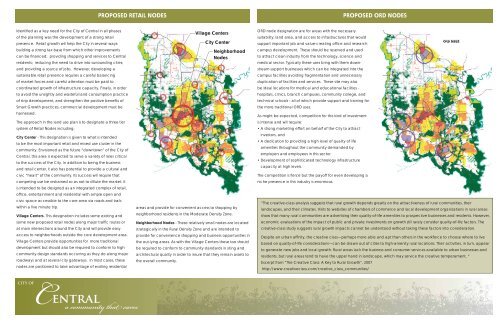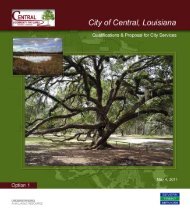master plan - City of Central
master plan - City of Central
master plan - City of Central
Create successful ePaper yourself
Turn your PDF publications into a flip-book with our unique Google optimized e-Paper software.
PROPOSED RETAIL NODES<br />
PROPOSED ORD NODES<br />
Identifi ed as a key need for the <strong>City</strong> <strong>of</strong> <strong>Central</strong> in all phases<br />
<strong>of</strong> the <strong>plan</strong>ning was the development <strong>of</strong> a strong retail<br />
presence. Retail growth will help the <strong>City</strong> in several ways:<br />
building a strong tax base from which other improvements<br />
can be fi nanced; providing shopping and services to <strong>Central</strong><br />
residents; reducing the need to drive into surrounding cities;<br />
and providing a source <strong>of</strong> jobs. However, developing a<br />
sustainable retail presence requires a careful balancing<br />
<strong>of</strong> market forces and careful attention must be paid to<br />
coordinated growth <strong>of</strong> infrastructure capacity. Finally, in order<br />
to avoid the unsightly and wasteful land consumption practice<br />
<strong>of</strong> strip development, and strengthen the positive benefi ts <strong>of</strong><br />
Smart Growth practices, commercial development must be<br />
harnessed.<br />
The approach in the land use <strong>plan</strong> is to designate a three tier<br />
system <strong>of</strong> Retail Nodes including:<br />
<strong>City</strong> Center - This designation is given to what is intended<br />
to be the most important retail and mixed use cluster in the<br />
community. Envisioned as the future “downtown” <strong>of</strong> the <strong>City</strong> <strong>of</strong><br />
<strong>Central</strong>, this area is expected to serve a variety <strong>of</strong> roles critical<br />
to the success <strong>of</strong> the <strong>City</strong>. In addition to being the business<br />
and retail center, it also has potential to provide a cultural and<br />
civic “heart” <strong>of</strong> the community. Its success will require that<br />
competing use be restrained so as not to dillute the market. It<br />
is intended to be designed as an integrated complex <strong>of</strong> retail,<br />
<strong>of</strong>fi ce, entertainment and residential with ample open and<br />
civic space accessible to the core area via roads and trails<br />
within a fi ve minute trip.<br />
Village Centers- This designation includes some existing and<br />
some new proposed retail nodes along major traffi c routes or<br />
at main intersections around the <strong>City</strong> and will provide easy<br />
access to neighborhoods outside the core development area.<br />
Village Centers provide opportunities for more traditional<br />
development but should also be required to conform to high<br />
community design standards occurring as they do along major<br />
roadways and at several city gateways. In most cases, these<br />
nodes are positioned to take advantage <strong>of</strong> existing residential<br />
Village Centers<br />
<strong>City</strong> Center<br />
Neighborhood<br />
Nodes<br />
areas and provide for convenient access to shopping by<br />
neighborhood residents in the Moderate Density Zone.<br />
Neighborhood Nodes - These relatively small nodes are located<br />
strategically in the Rural Density Zone and are intended to<br />
provide for convenience shopping and business opportunities in<br />
the out-lying areas. As with the Village Centers these too should<br />
be required to conform to community standards in siting and<br />
architectural quality in order to insure that they remain assets to<br />
the overall community.<br />
ORD node designation are for areas with the necessary<br />
suitability, land area, and access to infrastructures that would<br />
support important job and value-creating <strong>of</strong>fi ce and research<br />
campus development. These should be reserved and used<br />
to attract clean industry from the technology, science and<br />
medical sector. Typically these uses bring with them downstream<br />
support businesses which can be integrated into the<br />
campus facilities avoiding fragmentation and unnecessary<br />
duplication <strong>of</strong> facilities and services. These site may also<br />
be ideal locations for medical and educational facilities -<br />
hospitals, clinics, branch campuses, community college, and<br />
technical schools - all <strong>of</strong> which provide support and training for<br />
the more traditional ORD uses.<br />
As might be expected, competition for this kind <strong>of</strong> investment<br />
is intense and will require:<br />
• A strong marketing effort on behalf <strong>of</strong> the <strong>City</strong> to attract<br />
investors, and<br />
• A dedication to providing a high level <strong>of</strong> quality <strong>of</strong> life<br />
amenities throughout the community demanded by<br />
employers and employees in this sector.<br />
• Development <strong>of</strong> sophisticated technology infrastructure<br />
capacity at high levels.<br />
The competition is fi erce but the pay<strong>of</strong>f for even developing a<br />
niche presence in this industry is enormous.<br />
“The creative-class analysis suggests that rural growth depends greatly on the attractiveness <strong>of</strong> rural communities, their<br />
landscapes, and their climates. Visits to websites <strong>of</strong> chambers <strong>of</strong> commerce and local development organizations in rural areas<br />
show that many rural communities are advertising their quality-<strong>of</strong>-life amenities to prospective businesses and residents. However,<br />
economic evaluations <strong>of</strong> the impact <strong>of</strong> public and private investments on growth still rarely consider quality-<strong>of</strong>-life factors. The<br />
creative-class study suggests rural growth impacts cannot be understood without taking these factors into consideration.<br />
Despite an urban affi nity, the creative class—perhaps more able and apt than others in the workforce to choose where to live<br />
based on quality-<strong>of</strong>-life considerations—can be drawn out <strong>of</strong> cities to high-amenity rural locations. Their activities, in turn, appear<br />
to generate new jobs and local growth. Rural areas lack the business and consumer services available to urban businesses and<br />
residents, but rural areas tend to have the upper hand in landscape, which may service the creative temperament. “<br />
Excerpt from “The Creative Class: A Key to Rural Growth”, 2007<br />
http://www.creativeclass.com/creative_class_communities/<br />
CITY OF<br />
<strong>Central</strong><br />
a community that cares




